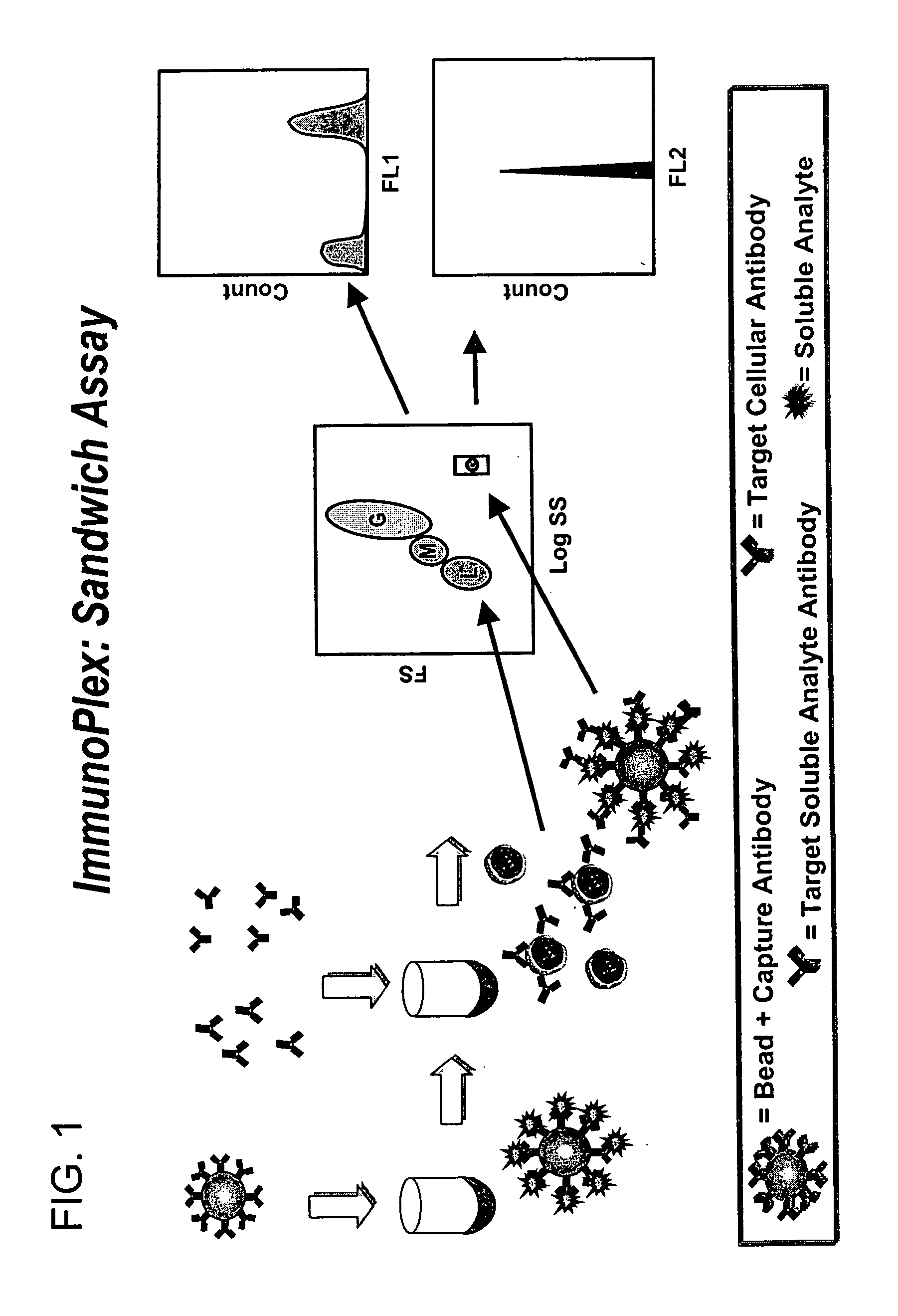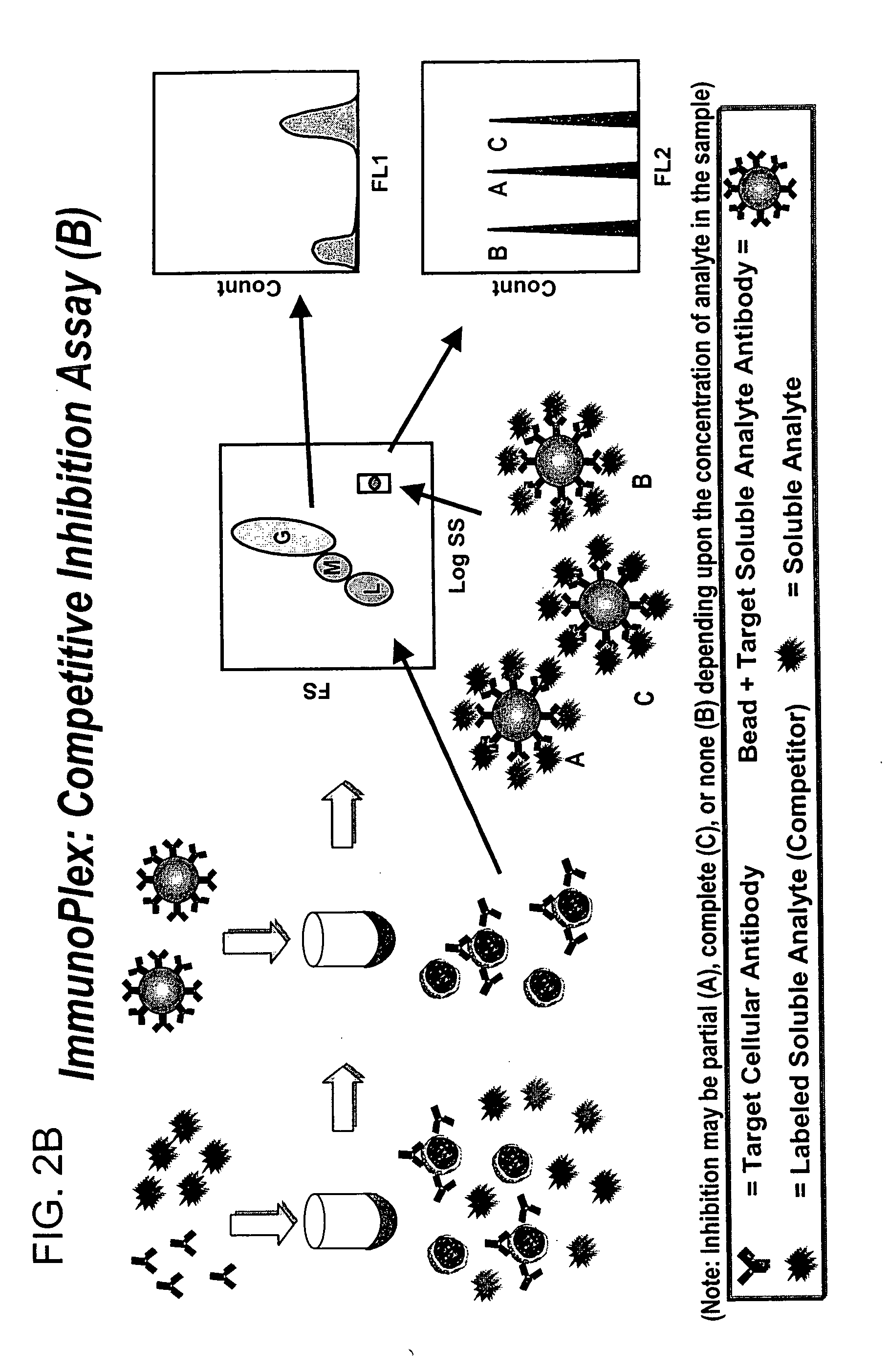Methods for substantially simultaneous evaluation of a sample containing a cellular target and a soluble analyte
a soluble analyte and substantially simultaneous technology, applied in the field of biological sample assay methods, can solve the problems of increasing the cost of the assay itself, introducing errors into the assay, and depleting the sample material
- Summary
- Abstract
- Description
- Claims
- Application Information
AI Technical Summary
Benefits of technology
Problems solved by technology
Method used
Image
Examples
example 1
ImmunoPlex Multiple Analyte Sandwich Immunoassay.
[0165] The following example was performed to test combined use of flow cytometry and immunoassay technology for substantially simultaneous assay of cellular marker expression profile (immunophenotyping), quantitation of soluble (serum markers), and white blood cell percentage in a single assay tube.
[0166] To a sample (100 uL) of EDTA-treated whole blood are added the following reagents: [0167] (a) The capture medium is 50 μl of a six-bead polystyrene microsphere bead population with distinct fluorescence intensities. The microspheres or beads are generally larger than 3.6 μm and smaller than 10 μm. Antibodies are individually covalently attached to a subset of the beads by conventional methods to create the antibody-conjugated fluorescence capture beads with bead specificity for IL-2, IL-4, IL-5, IL-10, TNF-α or IFNγ. [0168] (b) Phycoerythrin (PE)-conjugated anti-human detector soluble ligand (50 ul / test) with an antibody specific...
example 2
ImmunoPlex Single Analyte Capture Immunoassay
[0173] A sample of whole blood (100 μl) collected in the anticoagulant EDTA, is kept on ice or at room temperature throughout this experiment. Parallel samples were created by substituting plasma or buffer for the whole blood. To these samples were added the following reagents: [0174] (a) 10 μl of capture beads. As capture bead, a single non-fluorescent, paramagnetic, polystyrene microsphere is used to create six populations with bound antibodies to the soluble analyte IL2, i.e., human IL-2 antibodies. The beads are larger than 3.61 μm and smaller than 10 μm. [0175] (b) 20 μl of a ligand to the cellular target CD14, which is an antibody labeled with fluorescent isothiocyanate (anti-CD14-FITC) (Beckman Coulter); and [0176] (c) 10 μl of a ligand to the cellular target CD45, which is an antibody labeled with phycocyanin-5 (anti-CD45-PC5) (Beckman Coulter).
[0177] The samples are then incubated for 60 minutes mixing twice every 30 seconds (...
example 3
ImmunoPlex CD20
[0183] This example and FIG. 4 illustrate use of the invention methods to monitor treatment of a patient with a ligand (antibody) that binds to CD20. Whole blood, fine needle aspirates or bone marrow is placed in an analysis tube and components are stained by coincubation with the following components: [0184] a) an antibody that binds specifically to the cell surface expressed target, CD20, and which has been conjugated to a first distinguishable fluorescent label, fluorochrome 1 (Ab-FL1) (clone HRC20)-PE); [0185] b) a second antibody that identifies the cell lineage (i.e. CD19) and which is conjugated to a second distinguishable fluorescent label, fluorochrome 2 (Ab-FL2)(CD19-ECD®) a direct antibody conjugate; and [0186] c) a capture bead (as described in Example 2 above) that can be discriminated from cells by physical or fluorescent characteristics and is linked to CD20 antigen, for example, covalently (and / or a preserved cell that has a known expression of CD20 ...
PUM
 Login to View More
Login to View More Abstract
Description
Claims
Application Information
 Login to View More
Login to View More - R&D
- Intellectual Property
- Life Sciences
- Materials
- Tech Scout
- Unparalleled Data Quality
- Higher Quality Content
- 60% Fewer Hallucinations
Browse by: Latest US Patents, China's latest patents, Technical Efficacy Thesaurus, Application Domain, Technology Topic, Popular Technical Reports.
© 2025 PatSnap. All rights reserved.Legal|Privacy policy|Modern Slavery Act Transparency Statement|Sitemap|About US| Contact US: help@patsnap.com



